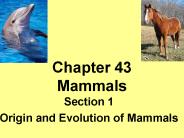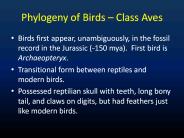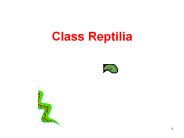Synapsids PowerPoint PPT Presentations
All Time
Recommended
Therapsids showed increasingly mammal-like characteristics. These smaller therapsids had smaller ribs in their lumbar region, like mammals. ...
| PowerPoint PPT presentation | free to view
Crocs ( and dinos?) muscles pulling liver backward and 'rocking' pelvic bones ... How could phylogeny explain the difference between turtles and crocs? ...
| PowerPoint PPT presentation | free to download
See a recovery after the Late Devonian extinction of tabulate ... by the placoderms, the stethacanthids exploded into a riot of bizarre forms and lifestyles. ...
| PowerPoint PPT presentation | free to download
Class Reptilia Subclass Synapsida Order Pelycosauria ... Echidna (monotreme, mammal) Tasmanian devil (marsupial, mammal) Kangaroo (marsupial, mammal) ...
| PowerPoint PPT presentation | free to view
... Lizards, snakes and amphisbaenians Fig 13-1 Iguanas, chameleons, agamids Skinks, alligator lizards, Snakes, amphisbaenians, Varanids, gila monsters, ...
| PowerPoint PPT presentation | free to download
early tetrapod modern reptile Modern Lepidosaurs (Reptiles) In Comparison to Synapsids/mammals: Jaw joint bones (articular and quadrate, + some others) shown in green.
| PowerPoint PPT presentation | free to view
Synapsids (mammals) Exercise 1. On your own face find your temporal fossa. Sketch your marine mammal skull, identify the mandible, orbit, sagittal crest, ...
| PowerPoint PPT presentation | free to view
Chapter 43 Mammals Section 1 Origin and Evolution of Mammals Characteristics Endothermy- regulate own body temperature- metabolism Hair- all mammals have some hair ...
| PowerPoint PPT presentation | free to view
KEY CONCEPT Reptiles were the first amniotes. Reptiles are a diverse group of amniotes. Reptiles share several characteristics. ectotherms covered with dry scales ...
| PowerPoint PPT presentation | free to download
They are names that are used for convenience in discussing vertebrate evolution. ... Salientia (Anura) 'Frogs' Urodela (Caudata) 'Salamanders' Tetrapoda: Amniota ...
| PowerPoint PPT presentation | free to view
GEOL 240 The Dinosaurs: Origin of Life and Fossil Record
| PowerPoint PPT presentation | free to view
Age of earth and solar system .4.5-4.6 bya (radioisotopic dating of meteorites)
| PowerPoint PPT presentation | free to view
Ovis aries. Q-A vs. D-S jaw joint- the defining key character' for 80 years ~250 MYA ... Traits evolve at multiple locations on phylogeny. Reptilia. Archosauria ...
| PowerPoint PPT presentation | free to view
LECTURE 7: Mesozoic Era 248 mya 65 mya Periods of the Mesozoic Era Triassic 248 mya-206 mya Jurassic 206 mya-146 mya Cretaceous 146 mya-65 mya What Significant ...
| PowerPoint PPT presentation | free to download
Snakes and lizards. Thecodonts (ancestral group of higher diapsids) Diapsids ... day lizards) was the sprawling stance imposed by the position of the legs ...
| PowerPoint PPT presentation | free to download
Archaeopteryx. Described in 1861. Origin of Species: 1859. 145 ... Archaeopteryx. Asymmetrical feathers. Curved claws on feet. Lacked supracoracoideus muscles ...
| PowerPoint PPT presentation | free to view
Herpetology. Ornithology. Mammalogy. Ichthyology. Class Chondrichthyes. Class Agnatha. Class Amphibia ... Lateral skeletal elements in appendage. fin rays in appendage ...
| PowerPoint PPT presentation | free to view
The Vertebrate Story
| PowerPoint PPT presentation | free to view
Class Chondrichthyes Herpetology is study of: Class Osteichthyes Class Mammalia Dinosauria Crocodilia Testudines Class Amphibia Class Agnatha Class Aves
| PowerPoint PPT presentation | free to view
Figure 34.2 Echinodermata Cephalochordata ANCESTRAL DEUTEROSTOME Chordates Urochordata Notochord Myxini Craniates Common ancestor of chordates Petromyzontida
| PowerPoint PPT presentation | free to view
Phylogeny of Birds Class Aves. Birds first appear, unambiguously, in the fossil record in the Jurassic (~ 150 mya). First bird is Archaeopteryx.
| PowerPoint PPT presentation | free to download
(1) Bottom-dwelling filter feeder with lophophore arms (2) ... (Cephalochordate) (Urochordate) (Enteropneusts) Possible evolutionary tree of early vertebrates ...
| PowerPoint PPT presentation | free to view
History of Life on Earth Chapter 25
| PowerPoint PPT presentation | free to download
The Late Paleozoic Era Geology 103 Sea level changes Kaskasia transgression starts in Devonian, continues to the end of the Mississippian Absaroka transgression ...
| PowerPoint PPT presentation | free to view
Evolution of the Animal Body Plan Part 2 Chordates and Vertebrates E. Q. How has the chordate body plan evolved over time to better suit these animals to their
| PowerPoint PPT presentation | free to view
Amniotes through Eutherians Chapter 34.6-34.8 By: Francisco Berrios and Siria Arzuaga Amniotes A group of tetrapods that trace back to the same common ancestor.
| PowerPoint PPT presentation | free to download
Triassic - North America and Gondwanaland rift apart; ... Africa and Antarctica/Australia rift apart. End of Jurassic - Eurasia rotates, closing off Tethys, ...
| PowerPoint PPT presentation | free to view
... into the Archosauromorpha (Crocs, birds, pterosaurs, and ... differently than crocs. move nares to top of skull. Saurischia. Palaeopoda (4-legged gait) ...
| PowerPoint PPT presentation | free to view
Macroevolution Evolutionary change above a species Evolution on a grand scale Species in a new habitat Mass extinctions Early Earth ... EARLY TETRAPODS ...
| PowerPoint PPT presentation | free to download
Vertebrates Emily Reiss Josie Jacob-Dolan Tori Willbanks-Roos
| PowerPoint PPT presentation | free to view
KEY CONCEPT Reptiles were the first amniotes. Reptiles are a diverse group of amniotes. Reptiles share several characteristics. ectotherms covered with dry scales ...
| PowerPoint PPT presentation | free to view
Archosauria (crocodiles, dinosaurs, pterosaurs, birds) Late Triassic ... Dinosaurs first appear as do mammals, turtles, and pterosaurs. Shallow warm seas ...
| PowerPoint PPT presentation | free to download
... Order Squamata Geckos Slide 26 Wall Lizard Lacerta Texas Horned Lizard Gila Monster Green Iguana Chameleons Komodo Dragon Snakes Swallow Prey Slide ...
| PowerPoint PPT presentation | free to view
* * * * What types of adaptations has the platypus evolved what purpose do these adaptations serve? Focus on: Appendages, Venom, and Sensory Adaptations.
| PowerPoint PPT presentation | free to download
What does life on land versus life in the ocean require? What evidence supports that the ... Diapsid - two holes (lizards, dinosaurs, snakes, crocs) ...
| PowerPoint PPT presentation | free to view
Title: Slide 1 Author: Computing & Information Services Last modified by: reviewer Created Date: 5/15/2006 7:16:30 PM Document presentation format
| PowerPoint PPT presentation | free to download
This 147-million-year-old Archaeopteryx fossil, owned by London's Natural History Museum, ... the world, Archaeopteryx is usually kept in environmentally ...
| PowerPoint PPT presentation | free to view
Mammals Chapter 43 Monotreme species: Only 5 living: duck-billed platypus & 4 species of echidna (spiny anteaters). Placental mammals 4000 described species,
| PowerPoint PPT presentation | free to view
... Most successful group of mammals Placental Mammals Competitive advantage over monotremes and marsupials Better nutrition from ... Canine Premolars ...
| PowerPoint PPT presentation | free to view
Chapter 34 The Origin and Evolution of Vertebrates
| PowerPoint PPT presentation | free to view
Amniota Amniote egg present Tetrapoda Girdles and limbs Teleostomi Vertebrates with endochondral bone Gnathostomata The jaw-bearing vertebrates Subphylum Vertebrata
| PowerPoint PPT presentation | free to view
Amniote origins and classification
| PowerPoint PPT presentation | free to view
Mesozoic Era (Jurassic Period)- Age of Reptiles ... Labyrinthodont amphibians led to stem ... Figure 5.14: (a) Archaeopteryx (b) pigeon. Literature Cited ...
| PowerPoint PPT presentation | free to view
Lecture 15The Age of Dinosaurs
| PowerPoint PPT presentation | free to view
Title: Slide 1 Author: Computing & Information Services Last modified by: reviewer Created Date: 5/12/2006 1:39:39 PM Document presentation format
| PowerPoint PPT presentation | free to download
... live in trees Africa and Madagascar Catch insects with tongue Komodo Dragon Attack and eat humans 10 feet long 300 pounds Indonesia Snakes Elongated derivative ...
| PowerPoint PPT presentation | free to download
... further reduction of the jugal in Archosauria (crocs and birds) and Lepidosauria results in a single temporal opening. (A fourth pattern, euryapsid, ...
| PowerPoint PPT presentation | free to download
Higher Chordates Amphibia, Reptilia, & Aves Subphyla Vertebrata Evolution of tetrapods One of the most significant events in vertebrate history was when the fins of ...
| PowerPoint PPT presentation | free to view
Order Primates - lemurs, monkeys and apes; 376 species. Order Rodentia - rodents; 2277 species ... Ancestral amniote skull types. ANAPSID 'stem reptiles' ...
| PowerPoint PPT presentation | free to view
Giant Volcanic Eruptions,
| PowerPoint PPT presentation | free to view
The Origin and Early Evolution of the Mammals Class Mammalia: ~4800 extant species (extremely diverse in size, form, and lifestyle); exhibit hair, mammary and sweat ...
| PowerPoint PPT presentation | free to view
Chapter 22: Specialized Teeth, Hair, Endothermy, and Viviparity Usual Fertilization Occurs in upper third of the oviduct within hours of copulation Delayed ...
| PowerPoint PPT presentation | free to download
Mammals Chapter 43 Table of Contents Section 1 Origin and Evolution of Mammals Section 2 Characteristics of Mammals Section 3 Diversity of Mammals
| PowerPoint PPT presentation | free to view
Lots of claws and teeth, including huge talon on one digit of forelimbs ... Dinosaurs were huge - could have been effectively homeothermic w/o endothermy ...
| PowerPoint PPT presentation | free to view
























































